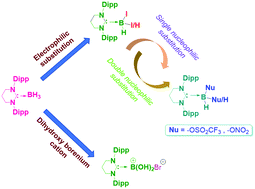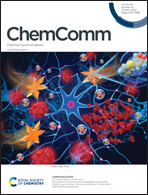Substitution at sp3 boron of a six-membered NHC·BH3: convenient access to a dihydroxyborenium cation†‡
Abstract
Herein, we have undertaken the synthesis and investigated the reactivity of a 6-membered saturated NHC borane adduct (1). Direct electrophilic halogenation of 1 with a stoichiometric amount of I2 led to NHC boryl iodides, 6-SIDipp·BH2I (2) and 6-SIDipp·BHI2 (3), which were further reacted with various nucleophiles to give novel 6-SIDipp based mono and disubstituted boranes with OTf (4 and 6) or ONO2 (5 and 7) functional groups. The addition of Br2/H2O to 1 smoothly results in a dihydroxyborenium cation (8).

- This article is part of the themed collection: #RSCPoster Conference


 Please wait while we load your content...
Please wait while we load your content...